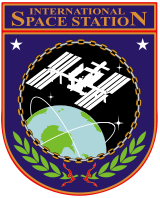
Back Internasionale Ruimtestasie Afrikaans Estación Espacial Internacional AN محطة الفضاء الدولية Arabic আন্তৰ্জাতিক মহাকাশ কেন্দ্ৰ Assamese Estación Espacial Internacional AST Beynəlxalq Kosmik Stansiya Azerbaijani Міжнародная касмічная станцыя Byelorussian Міжнародная касьмічная станцыя BE-X-OLD Международна космическа станция Bulgarian इंटरनेशनल स्पेस इस्टेशन Bihari
 ISS of STS-132 | |
 | |
| Station statistics | |
|---|---|
| SATCAT no. | 25544 |
| Call sign | Alpha, Station |
| Crew | Fully crewed: 3-6 Currently aboard: 7 (Expedition68) |
| Launch | 20 November 1998 |
| Launch pad | |
| Mass | ≈ 419,725 kg (925,335 lb)[1] |
| Length | 72.8 m (239 ft) |
| Width | 108.5 m (356 ft) |
| Height | ≈ 20 m (66 ft) nadir–zenith, arrays forward–aft (27 November 2009)[needs update] |
| Pressurised volume | 931.57 m3 (32,898 cu ft)[2] (28 May 2016) |
| Atmospheric pressure | 101.3 kPa (29.9 inHg; 1.0 atm) |
| Perigee | 408 km (253.5 mi) AMSL[3] |
| Apogee | 410 km (254.8 mi) AMSL[3] |
| Orbital inclination | 51.64°[3] |
| Orbital speed | 7.66 km/s[3] (27,600 km/h; 17,100 mph) |
| Orbital period | 92.68 minutes[3] |
| Orbits per day | 15.54[3] |
| Orbit epoch | 14 May 2019 13:09:29 UTC[3] |
| Days in orbit | 25 years, 7 months, 26 days (16 July 2024) |
| Days occupied | 23 years, 8 months, 14 days (16 July 2024) |
| No. of orbits | 116,178 as of May 2019[update][3] |
| Orbital decay | 2 km/month |
| Statistics as of 9 March 2011 (unless noted otherwise) References: [1][3][4][5][6] | |
| Configuration | |
 | |
The International Space Station (ISS) is a space station, a very large satellite that people can live in for several months at a time. It was put together in Low Earth orbit up until 2011, but other bits have been added since then. The last part, a Bigelow module was added in 2016. The station is a joint project among several areas of the world: the United States, Russia, Europe, Japan, and Canada. Other nations such as Brazil, Italy, and China also work with the ISS through cooperation with other countries.
Building the ISS began in 1998, when Russian and American space modules were joined together.
- ↑ 1.0 1.1 Garcia, Mark (9 May 2018). "About the Space Station: Facts and Figures". NASA. Retrieved 21 June 2018.
- ↑ "Space to Ground: Friending the ISS: 06/03/2016". YouTube.com. NASA. 3 June 2016.
- ↑ 3.0 3.1 3.2 3.3 3.4 3.5 3.6 3.7 3.8 Peat, Chris (28 September 2018). "ISS – Orbit". Heavens-Above. Retrieved 28 September 2018.
- ↑ Cite error: The named reference
OnOrbitwas used but no text was provided for refs named (see the help page). - ↑ "STS-132 Press Kit". NASA. 7 May 2010. Archived from the original (PDF) on 25 December 2018. Retrieved 19 June 2010.
- ↑ "STS-133 FD 04 Execute Package". NASA. 27 February 2011. Archived from the original (PDF) on 25 December 2018. Retrieved 27 February 2011.
© MMXXIII Rich X Search. We shall prevail. All rights reserved. Rich X Search